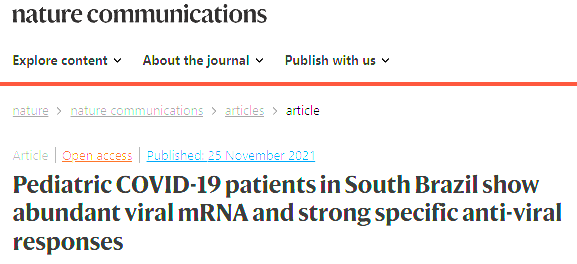Pediatric COVID-19 patients in South Brazil show abundant viral mRNA and strong specific anti-viral responses
COVID-19 manifests as a milder disease in children than adults, but the underlying mechanisms are not fully characterized. Here we assess the difference in cellular or humoral immune responses of pediatric and adult COVID-19 patients to see if these factors contribute to the severity dichotomy. Children's non-specific immune profile is dominated by naive lymphocytes and HLA-DRhighCX3CR1low dendritic cells; meanwhile, children show strong specific antibody and T cell responses for viral structural proteins, with their T cell responses differing from adults by having weaker CD8+TNF+ T cells responses to S peptide pool but stronger responses to N and M peptide pools. Finally, viral mRNA is more abundant in pediatric patients. Our data thus support a scenario in which SARS-CoV-2 infected children contribute to transmission yet are less susceptible to COVID-19 symptoms due to strong and differential responses to the virus.
Authors
Fazolo T, Lima K, Fontoura JC, de Souza PO, Hilario G, Zorzetto R, Júnior LR, Pscheidt VM, de Castilhos Ferreira Neto J, Haubert AF, Gambin I, Oliveira AC, Mello RS, de Bastos Balbe E Gutierres M, Gassen RB, Coimbra LD, Borin A, Marques RE, Sartor ITS, Zavaglia GO, Fernandes IR, Nakaya HI, Varela FH, Polese-Bonatto M, Borges TJ, Callegari-Jacques SM, da Costa MSC, de Araujo Schwartz J, Scotta MC, Stein RT, Bonorino C
External link
Publication Year
Publication Journal
Associeted Project
Microbiology or Immunology
Lista de serviços
-
As antisense RNA gets intronic.As antisense RNA gets intronic.
-
Androgen responsive intronic non-coding RNAs.Androgen responsive intronic non-coding RNAs.
-
Conserved tissue expression signatures of intronic noncoding RNAs transcribed from human and mouse loci.Conserved tissue expression signatures of intronic noncoding RNAs transcribed from human and mouse loci.
-
The intronic long noncoding RNA ANRASSF1 recruits PRC2 to the RASSF1A promoter, reducing the expression of RASSF1A and increasing cell proliferation.The intronic long noncoding RNA ANRASSF1 recruits PRC2 to the RASSF1A promoter, reducing the expression of RASSF1A and increasing cell proliferation.
-
Antisense intronic non-coding RNA levels correlate to the degree of tumor differentiation in prostate cancer.Antisense intronic non-coding RNA levels correlate to the degree of tumor differentiation in prostate cancer.
-
Insight Into the Long Noncoding RNA and mRNA Coexpression Profile in the Human Blood Transcriptome Upon Leishmania infantum Infection.Insight Into the Long Noncoding RNA and mRNA Coexpression Profile in the Human Blood Transcriptome Upon Leishmania infantum Infection.
-
Long non-coding RNAs associated with infection and vaccine-induced immunityLong non-coding RNAs associated with infection and vaccine-induced immunity
-
Comparative transcriptomic analysis of long noncoding RNAs in Leishmania-infected human macrophagesComparative transcriptomic analysis of long noncoding RNAs in Leishmania-infected human macrophages
-
SARS-CoV-2 Selectively Induces the Expression of Unproductive Splicing Isoforms of Interferon, Class I MHC, and Splicing Machinery Genes.SARS-CoV-2 Selectively Induces the Expression of Unproductive Splicing Isoforms of Interferon, Class I MHC, and Splicing Machinery Genes.

